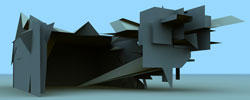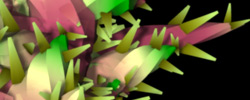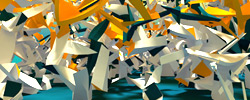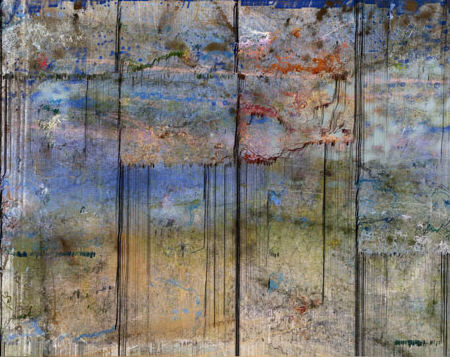An article in Wired magazine, Frame That Spam! Data-Crunching Artists Transform the World of Information, introduces several artists who transform found data into artistic creations. Their craft lies in the choice of data source to operate on, and the construction of an algorithm that manipulates the data to give results that are aethestically pleasing and/or conceptually interesting.
The art could be three-dimensional, as with the creations of Alex Dragulescu, though his objects are, as far as I can tell, not actually constructed, but merely rendered as images.



Dragulescu explains the series represented by the images above:
1. The images from the Spam Architecture series are generated by a computer program that accepts as input, junk email. Various patterns, keywords and rhythms found in the text are translated into three-dimensional modeling gestures.
2. Malwarez is a series of visualization of worms, viruses, trojans and spyware code. For each piece of disassembled code, API calls, memory addresses and subroutines are tracked and analyzed. Their frequency, density and grouping are mapped to the inputs of an algorithm that grows a virtual 3D entity. Therefore the patterns and rhythms found in the data drive the configuration of the artificial organism.
3. Extrusions in C Major is an experiment in music visualization. The composition used for these images is the Trio C-Major for Piano, Violin, and Cello by Wolfgang Amadeus Mozart.
The computer software analyzes a range of note characteristics such as value, velocity, duration, and overall tempo. The notes of the various instruments are differentiated by color: white for piano, yellow for violin, and blue for cello.
Further differences between the compositions is achieved through the rotation of forms while they grow and produce more curvy structures. These structures develop segment by segment, so each segment represents a note of a particular instrument from the composition. In addition, each note’s characteristic — velocity, value, and duration — is translated in the segment’s weight, length, and rotation.
My favorite works are perhaps the Dreamlines by Leonardo Solaas, which you can play a role in creating yourself:
Dreamlines is a non-linear, interactive visual experience. The user enters one or more words that define the subject of a dream he would like to dream. The system looks in the Web for images related to those words, and takes them as input to generate an ambiguous painting, in perpetual change, where elements fuse into one another, in a process analogous to memory and free association.

The control over the artwork exerted by these artists is at quite a high, conceptual level. Their algorithms are tuned for a class of data, not for specific data point by point. In this way it is unlike, say, an abstract painter adapting each gesture to the previous one, which might have owed some part to chance but is henceforth a fixed reality.
What do you think of this approach and these works?

Steve:
Undecided which post to place my comment.
Data points through a program reminds me of cracks and splotches on a wall as processed through the mind of Leonardo De Vinci. It would seem that an issue – and one that confronts me in my work – is the phenomenon of garbage-in-garbage out: except, in these cases the output is more like so many silk purses.
So you read Wired? For me it’s more like a bath than a read.
Steve,
I have been playing Dreamlines for an hour.
What fun! Some really interesting things came up for me.
I’ve been reading recently about Klee and Kandinsky and their interest in making visual and auditory (music) art more closely analogous, to find a visual language that would transcend — or circumvent entirely — the seemingly inevitable leap that our minds make from images to words/narrative. I wonder if these Found Dataists may have accomplished it.
I’ve also wiled away a good deal of time with Dreamlines. I’m looking into encaustics and the kind of images that arose are very provocative in that line. Thanks for the post.
I really really like the Dreamlines and got carried away for several hours. I like it both aesthetically (types of lines, colors, deep layering effects) and content-wise. Although some images seem random, not related to the keywords, it adds to the intrigue to try to figure out what is important and what is only Rosebud, Citizen Kane’s sled.
I was really amazed that computer generated stuff could be so engaging.
It looks like Dreamlines is a hit, and the reason must be that we can interact with it, to some degree guide it. The idea of interactive art is not all that new, but offhand I can’t think of any comparably open yet rich example. Does anybody else know of one?